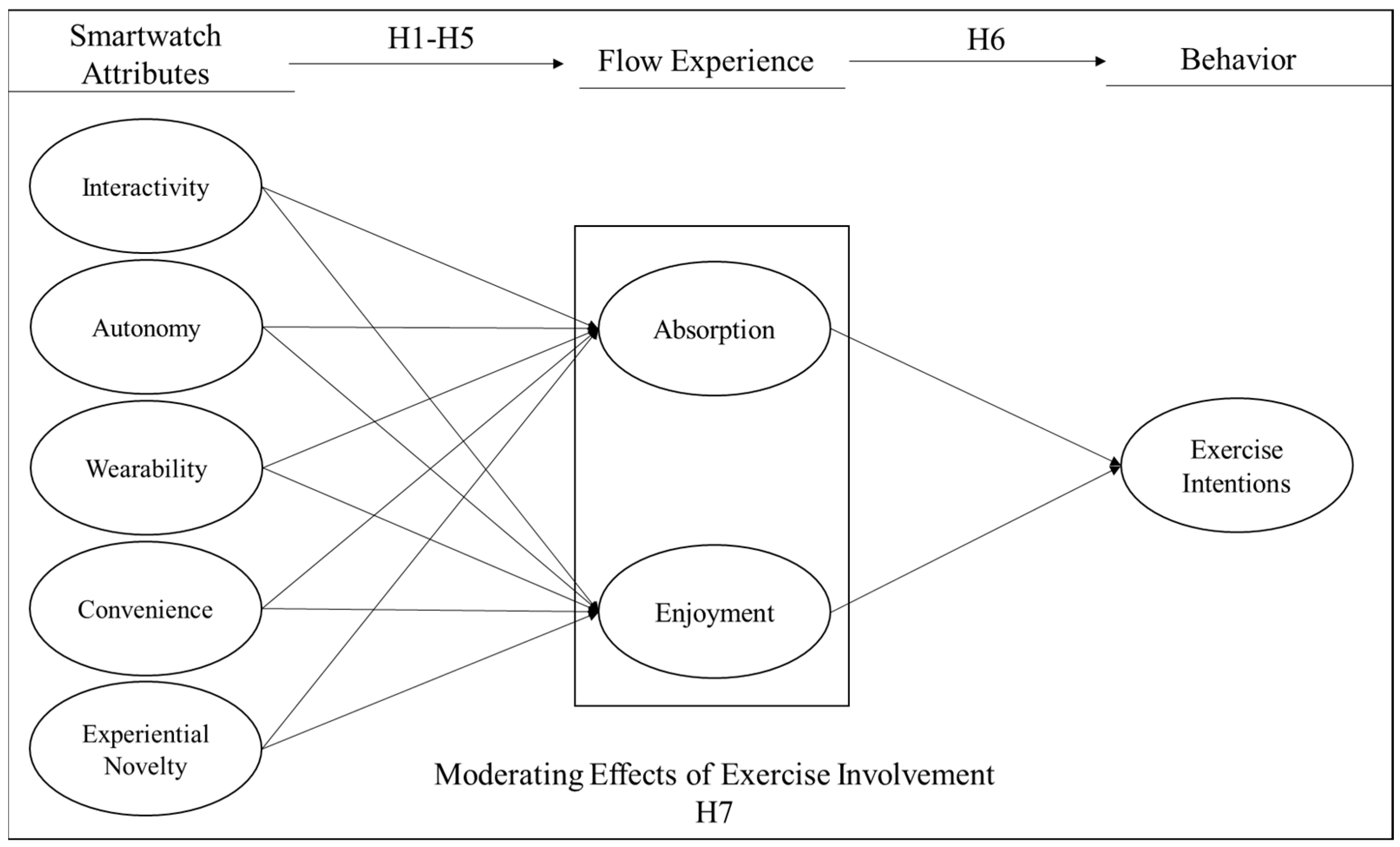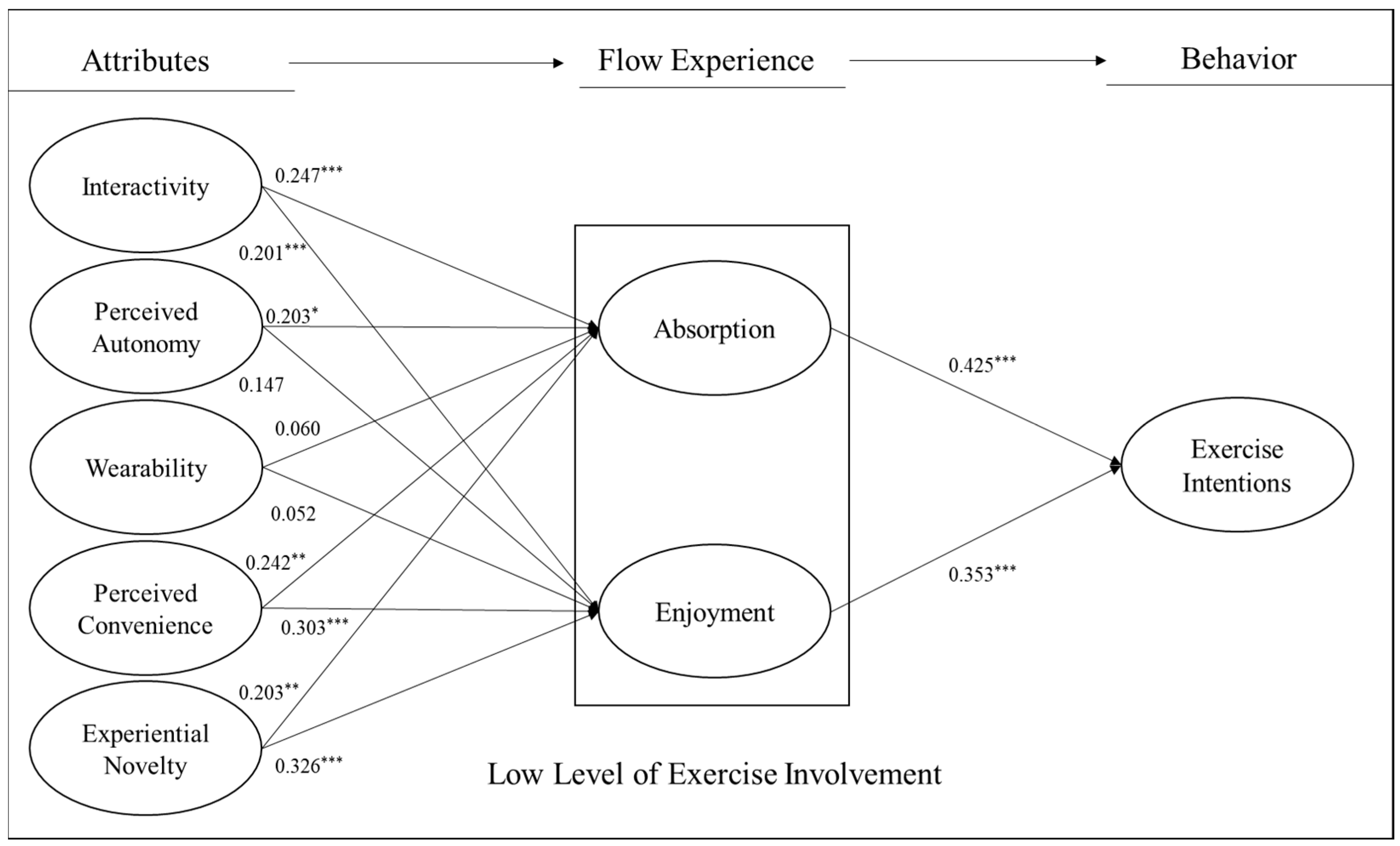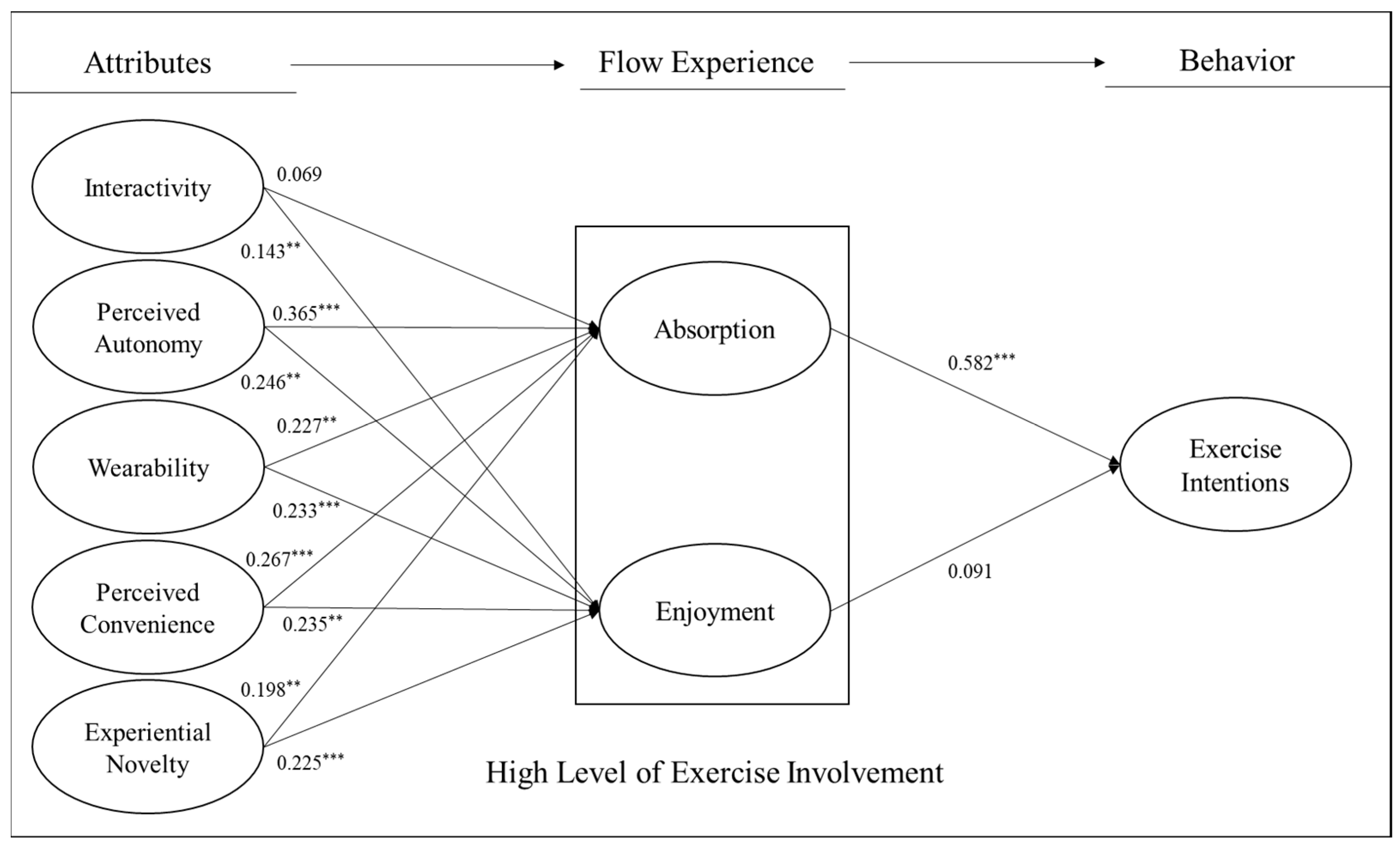Workout with a Smartwatch: A Cross-Sectional Study of the Effects of Smartwatch Attributes on Flow Experience and Exercise Intentions Depending on Exercise Involvement
Abstract
:1. Introduction
2. Methods
2.1. Participants and Procedure
2.2. Instrument
2.3. Data Analysis
3. Results
3.1. Measurement Model Validation
3.2. Measurement Model Invariance Test
3.3. Hypothesis Testing
4. Discussion
4.1. Interpretations of Results
4.2. Theoretical and Practical Implications
4.3. Limitations and Future Research Agendas
5. Conclusions
Author Contributions
Funding
Institutional Review Board Statement
Informed Consent Statement
Data Availability Statement
Conflicts of Interest
References
- Sallis, R.E. Exercise Is Medicine and Physicians Need to Prescribe It! Br. J. Sports Med. 2009, 43, 3–4. [Google Scholar] [CrossRef]
- Sari, N. Exercise, Physical Activity and Healthcare Utilization: A Review of Literature for Older Adults. Maturitas 2011, 70, 285–289. [Google Scholar] [CrossRef] [PubMed]
- Sari, N. Physical Inactivity and Its Impact on Healthcare Utilization. Health Econ. 2009, 18, 885–901. [Google Scholar] [CrossRef] [PubMed]
- Tappe, M.K.; Duda, J.L.; Ehrnwald, P.M. Perceived Barriers to Exercise among Adolescents. J. Sch. Health 1989, 59, 153–155. [Google Scholar] [CrossRef] [PubMed]
- Ebben, W.; Brudzynski, L. Motivations and barriers to exercise among college students. J. Exerc. Physiol. Online 2008, 11, 1–11. [Google Scholar]
- Jung, Y.; Kim, S.; Choi, B. Consumer Valuation of the Wearables: The Case of Smartwatches. Comput. Human. Behav. 2016, 63, 899–905. [Google Scholar] [CrossRef]
- Wu, L.-H.; Wu, L.-C.; Chang, S.-C. Exploring Consumers’ Intention to Accept Smartwatch. Comput. Human. Behav. 2016, 64, 383–392. [Google Scholar] [CrossRef]
- Dutot, V.; Bhatiasevi, V.; Bellallahom, N. Applying the Technology Acceptance Model in a Three-Countries Study of Smartwatch Adoption. J. High Technol. Manag. Res. 2019, 30, 1–14. [Google Scholar] [CrossRef]
- Kim, K.J.; Shin, D.-H. An Acceptance Model for Smart Watches: Implications for the Adoption of Future Wearable Technology. Internet Res. 2015, 25, 527–541. [Google Scholar] [CrossRef]
- Chen, J.; Wang, T.; Fang, Z.; Wang, H. Research on Elderly Users’ Intentions to Accept Wearable Devices Based on the Improved UTAUT Model. Front. Public Health 2023, 10, 1035398. [Google Scholar] [CrossRef]
- Huarng, K.-H.; Yu, T.H.-K.; Fang Lee, C. Adoption Model of Healthcare Wearable Devices. Technol. Forecast. Soc. Chang. 2022, 174, 121286. [Google Scholar] [CrossRef]
- Yang, Q.; Al Mamun, A.; Hayat, N.; Jingzu, G.; Hoque, M.E.; Salameh, A.A. Modeling the Intention and Adoption of Wearable Fitness Devices: A Study Using SEM-PLS Analysis. Front. Public Health 2022, 10, 918989. [Google Scholar] [CrossRef]
- Kim, K.J. Round or Square? How Screen Shape Affects Utilitarian and Hedonic Motivations for Smartwatch Adoption. Cyberpsychology Behav. Soc. Netw. 2016, 19, 733–739. [Google Scholar] [CrossRef]
- Larnyo, E.; Dai, B.; Larnyo, A.; Nutakor, J.A.; Ampon-Wireko, S.; Nkrumah, E.N.K.; Appiah, R. Impact of Actual Use Behavior of Healthcare Wearable Devices on Quality of Life: A Cross-Sectional Survey of People with Dementia and Their Caregivers in Ghana. Healthcare 2022, 10, 275. [Google Scholar] [CrossRef]
- Daniel Ruby Smartwatch Statistics 2023: How Many People Use Smartwatches? Available online: https://www.demandsage.com/smartwatch-statistics/ (accessed on 5 October 2023).
- Moye, R.; Towns, T.; Skipper, A.; Rose, D. Are Smartwatches Actually Used for Exercise? Evidence from HBCU Students. Am. J. Health Educ. 2022, 53, 219–227. [Google Scholar] [CrossRef]
- Magni, D.; Scuotto, V.; Pezzi, A.; Del Giudice, M. Employees’ Acceptance of Wearable Devices: Towards a Predictive Model. Technol. Forecast. Soc. Change 2021, 172, 121022. [Google Scholar] [CrossRef]
- Farivar, S.; Abouzahra, M.; Ghasemaghaei, M. Wearable Device Adoption among Older Adults: A Mixed-Methods Study. Int. J. Inf. Manag. 2020, 55, 102209. [Google Scholar] [CrossRef]
- Basha, N.K.; Aw, E.C.-X.; Chuah, S.H.-W. Are We so over Smartwatches? Or Can Technology, Fashion, and Psychographic Attributes Sustain Smartwatch Usage? Technol. Soc. 2022, 69, 101952. [Google Scholar] [CrossRef]
- Bölen, M.C. Exploring the Determinants of Users’ Continuance Intention in Smartwatches. Technol. Soc. 2020, 60, 101209. [Google Scholar] [CrossRef]
- Venkatesh, V.; Thong, J.Y.L.; Xu, X. Consumer Acceptance and Use of Information Technology: Extending the Unified Theory of Acceptance and Use of Technology. MIS Q. 2012, 36, 157–178. [Google Scholar] [CrossRef]
- Csikszentmihalyi, M. Flow: The Psychology of Optimal Experience; Harper & Row: New York, NY, USA, 1990. [Google Scholar]
- Csikszentmihalyi, M. Finding Flow: The Psychology of Engagement with Everyday Life; Basic Books: New York, NY, USA, 1997; ISBN 0465045138. [Google Scholar]
- Jackson, S.A.; Csikszentmihalyi, M. Flow in Sports; Human Kinetics: Champaign, IL, USA, 1999; ISBN 0880118768. [Google Scholar]
- Petosa, R.L.; Holtz, B. Flow for Exercise Adherence: Testing an Intrinsic Model of Health Behavior. Am. J. Health Educ. 2013, 44, 273–277. [Google Scholar] [CrossRef]
- Swann, C.; Jackman, P.C.; Schweickle, M.J.; Vella, S.A. Optimal Experiences in Exercise: A Qualitative Investigation of Flow and Clutch States. Psychol. Sport Exerc. 2019, 40, 87–98. [Google Scholar] [CrossRef]
- Schüler, J.; Brunner, S. The Rewarding Effect of Flow Experience on Performance in a Marathon Race. Psychol. Sport Exerc. 2009, 10, 168–174. [Google Scholar] [CrossRef]
- Cheng, T.-M.; Lu, C.-C. The Causal Relationships among Recreational Involvement, Flow Experience, and Well-Being for Surfing Activities. Asia Pac. J. Tour. Res. 2015, 20, 1486–1504. [Google Scholar] [CrossRef]
- Hsiao, K.-L.; Chen, C.-C. What Drives Smartwatch Purchase Intention? Perspectives from Hardware, Software, Design, and Value. Telemat. Inform. 2018, 35, 103–113. [Google Scholar] [CrossRef]
- Adapa, A.; Nah, F.F.-H.; Hall, R.H.; Siau, K.; Smith, S.N. Factors Influencing the Adoption of Smart Wearable Devices. Int. J. Hum. Comput. Interact. 2018, 34, 399–409. [Google Scholar] [CrossRef]
- Gopinath, K.; Sai, L.P. A Study on the Positioning of the Brand Variants by Smartwatch Manufacturers: A Technometrics Approach. Technol. Anal. Strateg. Manag. 2023, 35, 689–703. [Google Scholar] [CrossRef]
- Ogbanufe, O.; Gerhart, N. Watch It! Factors Driving Continued Feature Use of the Smartwatch. Int. J. Hum. Comput. Interact. 2018, 34, 999–1014. [Google Scholar] [CrossRef]
- Cho, W.-C.; Lee, K.Y.; Yang, S.-B. What Makes You Feel Attached to Smartwatches? The Stimulus–Organism–Response (S–O–R) Perspectives. Inf. Technol. People 2019, 32, 319–343. [Google Scholar] [CrossRef]
- Beer, J.M.; Fisk, A.D.; Rogers, W.A. Toward a Framework for Levels of Robot Autonomy in Human-Robot Interaction. J. Hum. Robot. Interact. 2014, 3, 74. [Google Scholar] [CrossRef]
- Jeong, H.; Kim, H.; Kim, R.; Lee, U.; Jeong, Y. Smartwatch Wearing Behavior Analysis: A Longitudinal Study. Proc. ACM Interact. Mob. Wearable Ubiquitous Technol. 2017, 1, 1–31. [Google Scholar] [CrossRef]
- Huang, M.-H. Designing Website Attributes to Induce Experiential Encounters. Comput. Human. Behav. 2003, 19, 425–442. [Google Scholar] [CrossRef]
- Skadberg, Y.X.; Kimmel, J.R. Visitors’ Flow Experience While Browsing a Web Site: Its Measurement, Contributing Factors and Consequences. Comput. Human. Behav. 2004, 20, 403–422. [Google Scholar] [CrossRef]
- Van Noort, G.; Voorveld, H.A.M.; Van Reijmersdal, E.A. Interactivity in Brand Web Sites: Cognitive, Affective, and Behavioral Responses Explained by Consumers’ Online Flow Experience. J. Interact. Mark. 2012, 26, 223–234. [Google Scholar] [CrossRef]
- Kim, D.; Ko, Y.J. The Impact of Virtual Reality (VR) Technology on Sport Spectators’ Flow Experience and Satisfaction. Comput. Human Behav. 2019, 93, 346–356. [Google Scholar] [CrossRef]
- Finneran, C.M.; Zhang, P. A Person–Artefact–Task (PAT) Model of Flow Antecedents in Computer-Mediated Environments. Int. J. Hum. Comput. Stud. 2003, 59, 475–496. [Google Scholar] [CrossRef]
- Hirao, K.; Kobayashi, R.; Okishima, K.; Tomokuni, Y. Flow Experience and Health-related Quality of Life in Community Dwelling Elderly Japanese. Nurs. Health Sci. 2012, 14, 52–57. [Google Scholar] [CrossRef]
- Ley, C.; Krammer, J.; Lippert, D.; Barrio, M.R. Exploring Flow in Sport and Exercise Therapy with War and Torture Survivors. Ment. Health Phys. Act. 2017, 12, 83–93. [Google Scholar] [CrossRef]
- Gómez-Rico, M.; Santos-Vijande, M.L.; Molina-Collado, A.; Bilgihan, A. Unlocking the Flow Experience in Apps: Fostering Long-term Adoption for Sustainable Healthcare Systems. Psychol. Mark. 2023, 40, 1556–1578. [Google Scholar] [CrossRef]
- Bakker, A.B.; Oerlemans, W.; Demerouti, E.; Slot, B.B.; Ali, D.K. Flow and Performance: A Study among Talented Dutch Soccer Players. Psychol. Sport Exerc. 2011, 12, 442–450. [Google Scholar] [CrossRef]
- Petty, R.E.; Cacioppo, J.T. The Elaboration Likelihood Model of Persuasion. In Communication and Persuasion; Springer: New York, NY, USA, 1986; pp. 1–24. [Google Scholar]
- Crowe, E.; Higgins, E.T. Regulatory Focus and Strategic Inclinations: Promotion and Prevention in Decision-Making. Organ. Behav. Hum. Decis. Process. 1997, 69, 117–132. [Google Scholar] [CrossRef]
- Tsai, J.-M.; Hung, S.-W.; Lin, G.-T. Continued Usage of Smart Wearable Devices (SWDs): Cross-Level Analysis of Gamification and Network Externality. Electron. Mark. 2022, 32, 1661–1676. [Google Scholar] [CrossRef] [PubMed]
- Jeong, S.C.; Choi, B.-J. Moderating Effects of Consumers’ Personal Innovativeness on the Adoption and Purchase Intention of Wearable Devices. Sage Open 2022, 12, 21582440221134800. [Google Scholar] [CrossRef]
- Kim, H.-M.; Cho, I.; Kim, M. Gamification Aspects of Fitness Apps: Implications of MHealth for Physical Activities. Int. J. Hum. Comput. Interact. 2023, 39, 2076–2089. [Google Scholar] [CrossRef]
- Stanley, D.M.; Cumming, J.; Standage, M.; Duda, J.L. Images of Exercising: Exploring the Links between Exercise Imagery Use, Autonomous and Controlled Motivation to Exercise, and Exercise Intention and Behavior. Psychol. Sport Exerc. 2012, 13, 133–141. [Google Scholar] [CrossRef]
- Zaichkowsky, J.L. Measuring the Involvement Construct. J. Consum. Res. 1985, 12, 341–352. [Google Scholar] [CrossRef]
- Hair, J.F.; Black, W.C.; Babin, B.J.; Anderson, R.E.; Tatham, R.L. Multivariate Data Analysis, 6th ed.; Pearson Prentice Hall: Uppersaddle River, NJ, USA, 2006. [Google Scholar]
- Fornell, C.; Larcker, D.F. Evaluating Structural Equation Models with Unobservable Variables and Measurement Error. J. Mark. Res. 1981, 18, 39–50. [Google Scholar] [CrossRef]
- Kline, R.B. Principles and Practice of Structural Equation Modeling; Guilford: New York, NY, USA, 2015; ISBN 1462523358. [Google Scholar]
- Fan, L.; Liu, X.; Wang, B.; Wang, L. Interactivity, Engagement, and Technology Dependence: Understanding Users’ Technology Utilisation Behaviour. Behav. Inf. Technol. 2017, 36, 113–124. [Google Scholar] [CrossRef]
- Dvorak, J.L. Moving Wearables into the Mainstream: Taming the Borg; Springer Science & Business Media: Berlin/Heidelberg, Germany, 2007; ISBN 0387691421. [Google Scholar]
- Hong, J.-C.; Lin, P.-H.; Hsieh, P.-C. The Effect of Consumer Innovativeness on Perceived Value and Continuance Intention to Use Smartwatch. Comput. Human Behav. 2017, 67, 264–272. [Google Scholar] [CrossRef]
- Uzir, M.U.H.; Al Halbusi, H.; Lim, R.; Jerin, I.; Hamid, A.B.A.; Ramayah, T.; Haque, A. Applied Artificial Intelligence and User Satisfaction: Smartwatch Usage for Healthcare in Bangladesh during COVID-19. Technol. Soc. 2021, 67, 101780. [Google Scholar] [CrossRef]
- Luo, Y.; Yang, L.; Ye, Q.; Liao, Q. Effects of Customization and Personalization Affordances on Perceived Value and Continuance Intention of Smartwatch Use. Technol. Forecast. Soc. Chang. 2023, 194, 122752. [Google Scholar] [CrossRef]
- Molanorouzi, K.; Khoo, S.; Morris, T. Motives for Adult Participation in Physical Activity: Type of Activity, Age, and Gender. BMC Public Health 2015, 15, 66. [Google Scholar] [CrossRef] [PubMed]
- Ingledew, D.K.; Markland, D. The Role of Motives in Exercise Participation. Psychol. Health 2008, 23, 807–828. [Google Scholar] [CrossRef] [PubMed]
- Maltby, J.; Day, L. The Relationship between Exercise Motives and Psychological Weil-Being. J. Psychol. 2001, 135, 651–660. [Google Scholar] [CrossRef]
- Kim, D.; Kim, A.; Kim, J.; Ko, Y.J. Symbiotic Relationship Between Sport Media Consumption and Spectatorship: The Role of Flow Experience and Hedonic Need Fulfillment. J. Glob. Sport Manag. 2020, 7, 112–134. [Google Scholar] [CrossRef]
- Oh, J.; Kim, D.H.; Kim, D. Exploring Experiential Patterns Depending on Time Lapses in Virtual Reality Spectatorship (VRS): The Role of Interruption in Reducing Satiation. Sustainability 2022, 14, 16678. [Google Scholar] [CrossRef]



| Factors and Items | λ | C.R. | AVE |
|---|---|---|---|
| Interactivity | 0.856 | 0.666 | |
| When I work out with my smartwatch, I can compare my amount of exercise with other users. | 0.827 | ||
| When I work out with my smartwatch, I can connect to and communicate with other users. | 0.759 | ||
| When I work out with my smartwatch, I can compare my exercise performance with other users on the app installed on my smartwatch. | 0.859 | ||
| Autonomy | 0.864 | 0.614 | |
| My smartwatch can automatically record my physiological information in anytime and everywhere. | 0.766 | ||
| My smartwatch can automatically measure my physiological state and exercise performance. | 0.753 | ||
| My smartwatch enables me access to the information about my physiological state and exercise performance in anytime and everywhere. | 0.806 | ||
| My smartwatch performs tasks with my least effort and intervention | 0.807 | ||
| Wearability | 0.866 | 0.683 | |
| When I wear my smartwatch, I feel comfortable. | 0.742 | ||
| I do not feel my smartwatch interferes my movements. | 0.851 | ||
| When I wear my smartwatch, I do not feel any inconvenience | 0.880 | ||
| Convenience | 0.929 | 0.813 | |
| My smartwatch allows me to simultaneously perform many tasks during exercise. | 0.868 | ||
| My smartwatch allows me to easily perform many tasks during exercise. | 0.931 | ||
| My smartwatch allows me to conveniently perform many tasks during exercise. | 0.905 | ||
| Experiential Novelty | 0.948 | 0.819 | |
| Working out with the smartwatch gives me a unique experience. | 0.807 | ||
| Working out with the smartwatch gives me a novel experience. | 0.918 | ||
| Working out with the smartwatch gives me an unusual experience. | 0.960 | ||
| Working out with the smartwatch gives me a new experience. | 0.928 | ||
| Absorption | 0.949 | 0.860 | |
| When I work out with my smartwatch, I am totally focused on it. | 0.904 | ||
| When I work out with my smartwatch, I am totally engrossed in it. | 0.950 | ||
| When I work out with my smartwatch, I am absorbed intensely. | 0.929 | ||
| Enjoyment | 0.950 | 0.864 | |
| Working out with the smartwatch is enjoyable. | 0.925 | ||
| Working out with the smartwatch is exciting. | 0.931 | ||
| Working out with the smartwatch is fun. | 0.932 | ||
| Exercise Intention | 0.933 | 0.824 | |
| I would like to continue working out with my smartwatch. | 0.961 | ||
| It is highly likely for me to work out with my smartwatch. | 0.945 | ||
| I will continue to work out with my smartwatch. | 0.810 | ||
| Exercise Involvement | 0.929 | 0.815 | |
| I am highly interested in exercise. | 0.876 | ||
| Exercise is important to me. | 0.905 | ||
| Exercise is of high value to me. | 0.926 |
| 1 | 2 | 3 | 4 | 5 | 6 | 7 | 8 | 9 | |
|---|---|---|---|---|---|---|---|---|---|
| 1 Interactivity | 0.666 | 0.100 * | 0.073 * | 0.105 * | 0.084 * | 0.190 * | 0.194 * | 0.141 * | 0.092 * |
| 2 Autonomy | 0.316 | 0.614 | 0.303 * | 0.318 * | 0.157 * | 0.285 * | 0.256 * | 0.317 * | 0.093 * |
| 3 Wearability | 0.271 | 0.535 | 0.683 | 0.323 * | 0.190 * | 0.235 * | 0.241 * | 0.327 * | 0.034 * |
| 4 Convenience | 0.324 | 0.564 | 0.568 | 0.813 | 0.328 * | 0.342 * | 0.355 * | 0.247 * | 0.066 * |
| 5 Novelty | 0.289 | 0.396 | 0.436 | 0.573 | 0.819 | 0.289 * | 0.335 * | 0.161 * | 0.100 * |
| 6 Absorption | 0.436 | 0.534 | 0.485 | 0.585 | 0.538 | 0.860 | 0.790 * | 0.465 * | 0.230 * |
| 7 Enjoyment | 0.441 | 0.506 | 0.491 | 0.596 | 0.579 | 0.889 | 0.864 | 0.416 * | 0.184 * |
| 8 Intention | 0.375 | 0.563 | 0.572 | 0.497 | 0.401 | 0.682 | 0.645 | 0.824 | 0.108 * |
| 9 Involvement | 0.303 | 0.305 | 0.185 | 0.257 | 0.316 | 0.480 | 0.429 | 0.329 | 0.815 |
| Model | Model Fit Indices | Model Comparison |
|---|---|---|
| Model 1: Measurement model without constraints | χ2/df = 1207.370/542, CFI = 0.953, TLI = 0.943, RMSEA = 0.064, SRMR = 0.055 | |
| Model 2: Model 1 + Equal Factor Loadings | χ2/df = 1223.816/560, CFI = 0.953, TLI = 0.945, RMSEA = 0.063, SRMR = 0.058 | ∆χ2 = 16.446, ∆df = 18, p = 0.562 |
| Model 3: Structural model without constraints | χ2/df = 1726.711/590, CFI = 0.919, TLI = 0.911, RMSEA = 0.080, SRMR = 0.089 | |
| Model 4: Model 3 + Equal path coefficients | χ2/df = 1749.942/602, CFI = 0.918, TLI = 0.912, RMSEA = 0.080, SRMR = 0.092 | ∆χ2 = 23.231, ∆df = 12, p < 0.05 |
Disclaimer/Publisher’s Note: The statements, opinions and data contained in all publications are solely those of the individual author(s) and contributor(s) and not of MDPI and/or the editor(s). MDPI and/or the editor(s) disclaim responsibility for any injury to people or property resulting from any ideas, methods, instructions or products referred to in the content. |
© 2023 by the authors. Licensee MDPI, Basel, Switzerland. This article is an open access article distributed under the terms and conditions of the Creative Commons Attribution (CC BY) license (https://creativecommons.org/licenses/by/4.0/).
Share and Cite
Oh, J.; Kim, D. Workout with a Smartwatch: A Cross-Sectional Study of the Effects of Smartwatch Attributes on Flow Experience and Exercise Intentions Depending on Exercise Involvement. Healthcare 2023, 11, 3074. https://doi.org/10.3390/healthcare11233074
Oh J, Kim D. Workout with a Smartwatch: A Cross-Sectional Study of the Effects of Smartwatch Attributes on Flow Experience and Exercise Intentions Depending on Exercise Involvement. Healthcare. 2023; 11(23):3074. https://doi.org/10.3390/healthcare11233074
Chicago/Turabian StyleOh, Jihyeon, and Daehwan Kim. 2023. "Workout with a Smartwatch: A Cross-Sectional Study of the Effects of Smartwatch Attributes on Flow Experience and Exercise Intentions Depending on Exercise Involvement" Healthcare 11, no. 23: 3074. https://doi.org/10.3390/healthcare11233074
APA StyleOh, J., & Kim, D. (2023). Workout with a Smartwatch: A Cross-Sectional Study of the Effects of Smartwatch Attributes on Flow Experience and Exercise Intentions Depending on Exercise Involvement. Healthcare, 11(23), 3074. https://doi.org/10.3390/healthcare11233074







